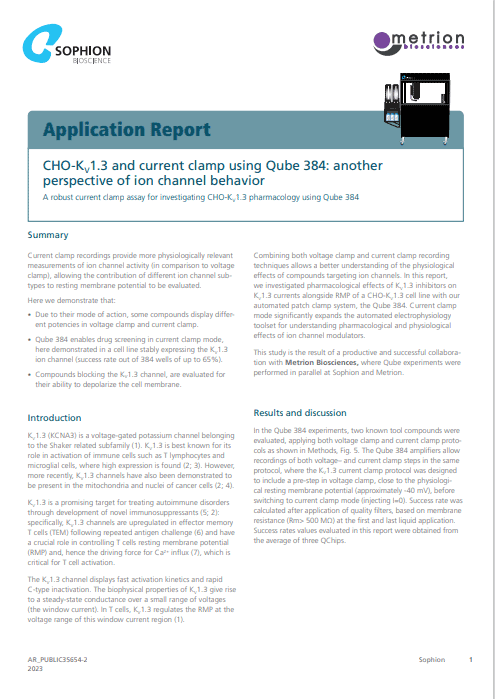CHO-KV 1.3 and current clamp using Qube 384: another perspective of ion channel behaviour

Application report
Application report title
CHO-KV 1.3 and current clamp using Qube 384: another perspective of ion channel behaviour
Summary
Current clamp recordings provide more physiologically relevant measurements of ion channel activity (in comparison to voltage clamp), allowing the contribution of different ion channel sub-types to resting membrane potential to be evaluated.
Please contact us if you would like any further information regarding our suite of KV 1.3 services or Qube screening services.
Extract
Introduction
KV1.3 (KCNA3) is a voltage-gated potassium channel belonging to the Shaker related subfamily (1). KV1.3 is best known for its role in activation of immune cells such as T lymphocytes and microglial cells, where high expression is found. However, more recently, KV1.3 channels have also been demonstrated to be present in the mitochondria and nuclei of cancer cells. KV1.3 is a promising target for treating autoimmune disorders through development of novel immunosuppressants : specifically, KV1.3 channels are upregulated in effector memory T cells (TEM) following repeated antigen challenge (6) and have a crucial role in controlling T cells resting membrane potential (RMP) and, hence the driving force for Ca2+ influx (7), which is critical for T cell activation. The KV1.3 channel displays fast activation kinetics and rapid C-type inactivation. The biophysical properties of KV1.3 give rise to a steady-state conductance over a small range of voltages (the window current). In T cells, KV1.3 regulates the RMP at the voltage range of this window current region (1). Combining both voltage clamp and current clamp recording techniques allows a better understanding of the physiological effects of compounds targeting ion channels. In this report, we investigated pharmacological effects of KV1.3 inhibitors on KV1.3 currents alongside RMP of a CHO-KV1.3 cell line with our automated patch clamp system, the Qube 384. Current clamp mode significantly expands the automated electrophysiology toolset for understanding pharmacological and physiological effects of ion channel modulators. This study is the result of a productive and successful collaboration with Metrion Biosciences, where Qube experiments were performed in parallel at Sophion and Metrion
This study is the result of a productive and successful collaboration with Metrion Biosciences, where Qube experiments were performed in parallel at Sophion and Metrion.
